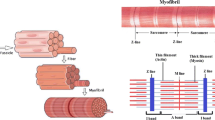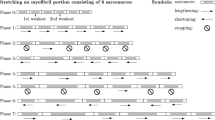Summary
The peculiar functional structure of the Z-line in the obliquely striated muscles of some feather stars is described. It is known that cross-striated muscles are characterized by linear and continuous Z-bands, and obliquely striated muscles by disconnected, obliquely aligned Z-elements. Owing to this discontinuous organization, the sarcomere can perform wide active lengthenings, shortenings, and even ‘super-elongations’ in the helical fibres. In contrast, the obliquely striated fibres of crinoids show markedly continuous and homogeneous oblique Z-lines; such a structure is not compatible with ‘super-performances’ like sliding and shearing of the sarcomere elements, but instead could allow functions comparable to those characteristic of a cross-striated muscle (quick, short movements, mechanically amplifiable by bone levers). This odd situation, only interpretable in terms of evolutionary constraint, could be considered opposite and symmetrical to that of cross-striated ‘super-contracting’ muscles, where the Z-line is exceptionally fragmented to allow the sarcomere to super-contract.
The possible architecture of a significant parameter such as the Z-line, which determines muscle fibre potential capacities, is analysed in detail: (1) through qualitative-quantitative evaluation of electron micrographs, supported by statistical analysis of the data; and (2) bycomputer simulations. The data obtained suggest that the most realistic conformation of the whole Z-complex in these muscles consists of a multiple system of continuous, ribbon-like helical planes running in parallel along the fibre from end to end and regularly cutting it with a constant thickness. The proposed model seems morphologically compatible with the experimentally verified situations and functionally compatible with the mechanical requirements for a normal contraction and for a balanced distribution of the involved strengths.
Similar content being viewed by others
References
Bouligand, Y. (1966) La disposition des myofilaments chez une Annelide Polychete.J. Microsc. 5, 305–22.
Candia Carnevali, M. D. (1978) Z-line and supercontraction in the hydraulic muscular systems of insect larvae.J. exp. Zool. 203, 15–29.
Candia Carnevali, M. D. &Saita, A. (1985a) Muscle system organization in the Echinoderms. II. Microscopic anatomy and functional significance of the muscleligament-skeleton system in the arm of the comatulids (Antedon mediterranea).J. Morphol. 185, 59–74.
Candia Carnevali, M. D. &Saita, A. (1985b) Muscle system organization in the Echinoderms. III. Fine structure of the contractile apparatus of the arm flexor muscles of the comatulids (Antedon mediterranea).J. Morphol. 185, 75–87.
Candia Carnevali, M. D., Saita, A. &Fedrigo, A. (1986) Z-line in the obliquely striated muscles of crinoids: morphofunctional analysis and computer model. Proceedings of 14th European Conference on Muscle and Motility.J. Musc. Res. Cell Motility 7, 76.
Candia Carnevali, M. D. &Valvassori, R. (1981) Z-lines in the insect muscles: correlated structural and functional diversities.Boll. Zool. 48, 1–9.
Goldstein, M. A., Schroeter, J. P. &Sass, R. L. (1982) The Z-band lattice in a slow skeletal muscle.J. Musc. Res. Cell Motility 3, 333–48.
Inglis, W. G. (1983) The structure and operation of the obliquely striated supercontractile somatic muscles in nematodes.Aust. J. Zool. 31, 677–93.
Lanzavecchia, G. (1977) Morphological modulations in helical muscles (Aschelminthes and Annelida).Int. Rev. Cytol. 51, 133–86.
Lanzavecchia, G. (1981) Morphofunctional and phylogenetic relations in helical muscles.Boll. Zool. 48, 29–40.
Lanzavecchia, G. &Arcidiacono, G. (1981) Contraction mechanism of helical muscles: Experimental and theoretical analysis.J. Submicr. Cytol. 13, 253–66.
Lanzavecchia, G., Candia Carnevali, M. D., DE Eguileor, M. &Valvassori, R. (1984) Linea-Z nei muscoli a striatura obliqua: differenziazioni morfologiche e funzionali.Boll. Zool. 51, 59.
Lanzavecchia, G., DE Eguileor, M. &Valvassori, R. (1985) Superelongation in helical muscles of leeches.J. Musc. Res. Cell Motility 6, 569–84.
Moens, P. B. &Moens, T. (1981) Computer measurements and graphics of three-dimensional cellular ultrastructure.J. Ultrastruct. Res. 75, 131–41.
Partridge, D. &Lopez, P. D. (1984) Computer programs as theories in biology.J. Theoret. Biol. 108, 539–64.
Ripley, B. D. (1981)Spatial Statistics. New York, Chichester, Brisbane, Toronto: John Wiley.
Rosenbluth, J. (1972) Obliquely striated muscle. InThe Structure and Function of Muscle (edited byBourne, G. H.), Vol. I, pp. 389–420. New York: Academic Press.
Shafer, S. a. (1985)Shadows and Silhouettes in Computer Vision. Boston, Dordrecht, Lancaster: Kluwer Academic Publishers.
Woittiez, R. D., Huijing, P. A., Boom, H. B. K. &Rozendal, R. H. (1984) A three-dimensional muscle model: a quantified relation between form and function of skeletal muscles.J. Morphol. 185, 95–113.
Yamaguchi, M. &Izumimoto, M. (1985) Fine structure of wide and narrow vertebrate muscle Z-lines. A proposed model and computer simulations of Z-line architecture.J. molec. Biol. 184, 621–44.
Author information
Authors and Affiliations
Rights and permissions
About this article
Cite this article
Candia Carnevali, M.D., Saita, A. & Fedrigo, A. An unusual Z-system in the obliquely striated muscles of crinoids: three-dimensional structure and computer simulations. J Muscle Res Cell Motil 7, 568–578 (1986). https://doi.org/10.1007/BF01753572
Received:
Revised:
Issue Date:
DOI: https://doi.org/10.1007/BF01753572




